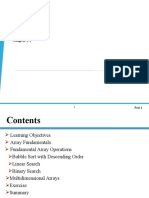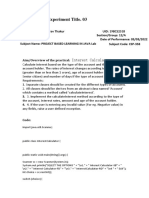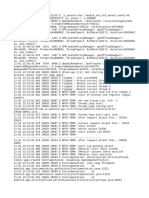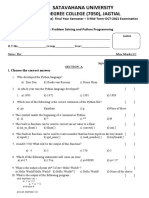0% found this document useful (0 votes)
72 views51 pagesArray and Pointer - 2
The document provides an introduction to arrays and pointers in C++. It covers:
1) One-dimensional arrays including declaration, initialization, accessing elements, and passing arrays as arguments.
2) Two-dimensional arrays including declaration, initialization, and accessing elements.
3) Addresses and pointers including obtaining addresses, pointer declaration and initialization, dereferencing pointers, and using array names as pointers.
4) Pointer arithmetic.
Uploaded by
GENENE TISECopyright
© © All Rights Reserved
We take content rights seriously. If you suspect this is your content, claim it here.
Available Formats
Download as PDF, TXT or read online on Scribd
0% found this document useful (0 votes)
72 views51 pagesArray and Pointer - 2
The document provides an introduction to arrays and pointers in C++. It covers:
1) One-dimensional arrays including declaration, initialization, accessing elements, and passing arrays as arguments.
2) Two-dimensional arrays including declaration, initialization, and accessing elements.
3) Addresses and pointers including obtaining addresses, pointer declaration and initialization, dereferencing pointers, and using array names as pointers.
4) Pointer arithmetic.
Uploaded by
GENENE TISECopyright
© © All Rights Reserved
We take content rights seriously. If you suspect this is your content, claim it here.
Available Formats
Download as PDF, TXT or read online on Scribd
/ 51




































































































